In an era of accelerating digitization, voice search offered users the perfect blend of convenience and swiftness. Performing searches in a conversational tone, not having to scour through search result pages, and receiving bite-sized, accurate answers all proved to possess undeniable allure. However, no such shifts in consumers’ habits could come without turmoil on the marketers’ side. Indeed, this development has a profound impact on digital marketing, from Search Engine Optimization (SEO) to content strategies. From how users receive their answers to how the results match their search intent and more, inevitable change looms ahead. To prove this point, let us explore the exact impact of voice search on digital marketing and SEO – starting from this phenomenon’s fundamentals.
An introduction to voice search
First, let us explore voice search in itself. Namely, its definition and expansion, common uses and benefits, and overlaps with specific marketing subsets. This will help contextualize its implications for digital marketing and SEO, and eventually inform optimization options.

Defining voice search
Initially, let us briefly define voice search. Techopedia defines it as follows:
“Voice search is a speech recognition technology that allows a user to perform a search via a voice command. Although designed to be a software application, voice search also may be used as a service by smartphones and other small Web-enabled devices. Voice search is also known as voice-enabled search.”
Here, you may notice that this definition is from 2011. Indeed, voice search is far from a novel concept, and has existed in slightly different forms for many years. For instance, TechFunnel defines it in 2020 as follows:
“Voice-search is basically an approach of advanced technology that uses voice-enabled commands to carry out a search on the internet browser, your phone or on any application.”
As you can see, the fundamental concept remains unchanged almost a decade later. However, the second definition delves deeper into the technological changes surrounding it, continuing to note that:
“[Voice search] includes an open-domain short keyword query to fetch any information on the internet. Google Voice search, Siri and Alexa are some voice assistants that carry out voice searches.”
Thus, a central factor lies in exactly how voice search functions, and how it has evolved over the years. For example, the following illustration from SmartInsights maps query analysis from a linguistic perspective:
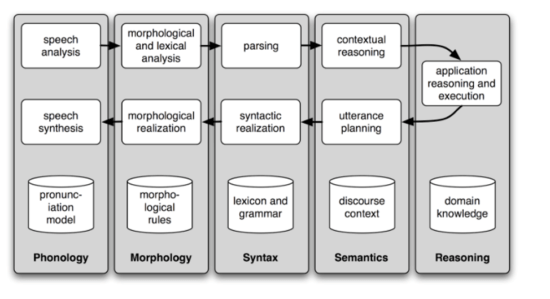
It is this gradual shift and expansion that may begin to outline the impact of voice search on digital marketing and SEO. In brief, two factors follow it:
- Search engines’ handling of voice search, and
- The availability and popularity of voice search.
These two factors ultimately inform how exactly voice search functions, and the use quality and quantity it sees.
Virtual assistants and smart speakers
Starting with the latter, voice search has become a staple, almost definitionally built-in, function of virtual assistants like:
- Google Assistant
- Siri
- Alexa
- Cortana
- Bixby
What’s more, such virtual assistants are no longer confined to smartphones alone. Many continue to find their way into smart devices such as Smart TVs and wearables. Others reside in their own smart speakers, like Alexa does in Echo.
This is a crucial note to make, as both of these distinct items continue to expand their reach and appeal. From commercial convenience to cultural acceptance, their sheer availability has fueled voice search like never before – with content marketing trends following suit.
The expanding penetration of voice search and voice devices
To elaborate on this expansion, we may cite Invoca. Citing PwC themselves, they note that “voice-enabled device interaction is becoming a part of consumers’ day-to-day routine”, with strong evidence to support their claim.
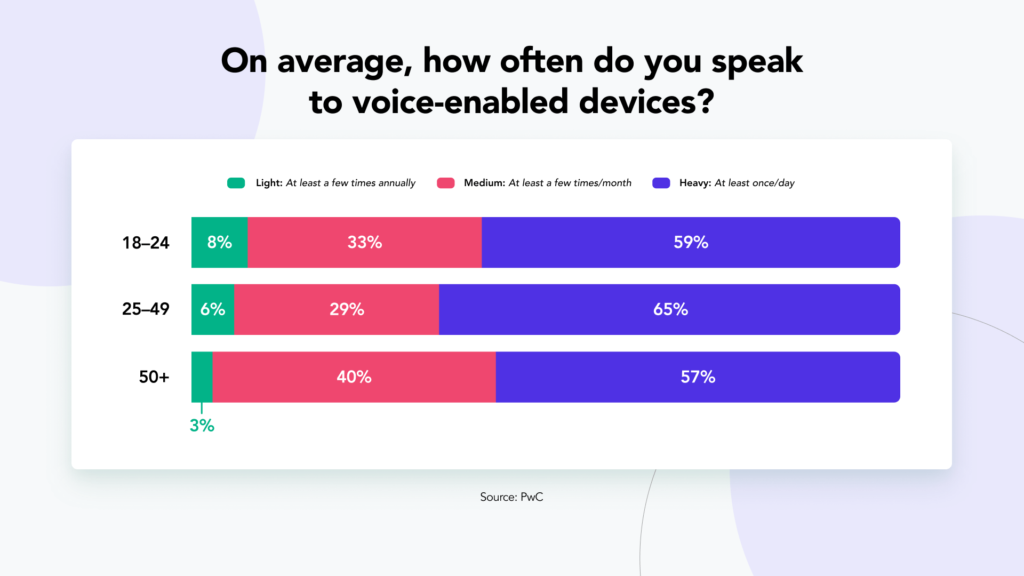
These findings may only signify voice-enabled devices’ current popularity, but the ones that follow seem to outline its near-certain expansion:
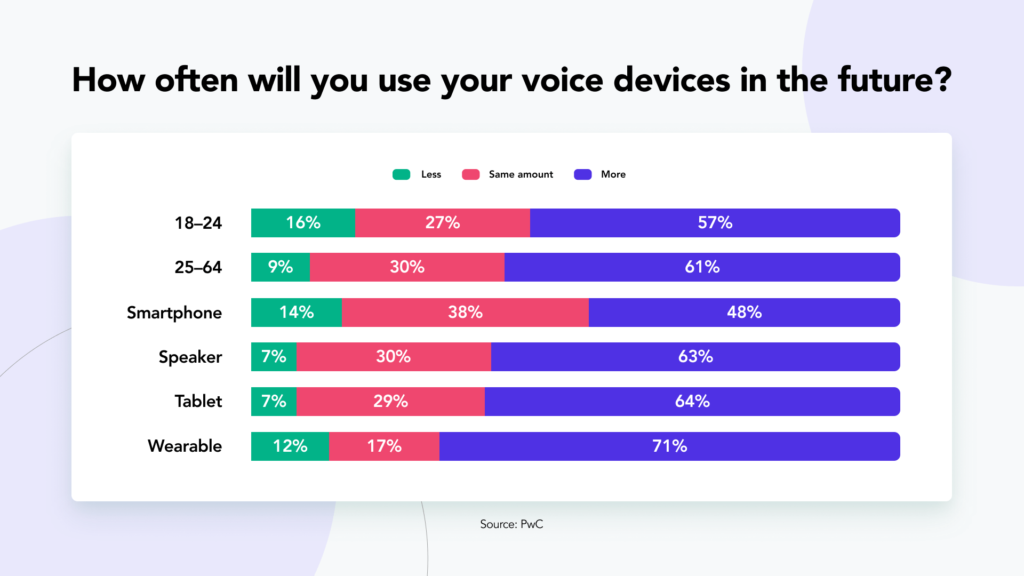
This phenomenon does differ among different age groups and device types, but the overall trend should be clear. Voice search continues to expand, as statistics note as well:
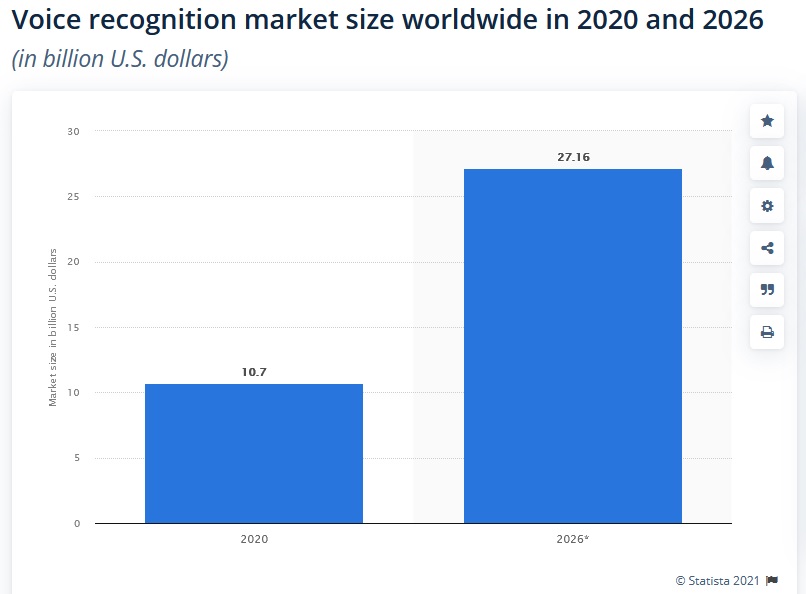
Specifically, it forecasts that the global voice recognition market size will grow “from 10.7 billion U.S. dollars in 2020 to 27.16 billion U.S. dollars by 2026”. “The estimated CAGR from 2021 to 2026 amounts to 16.8 percent”, and should continue to hint at the impact of voice search on digital marketing and SEO.
But why is this occurring? Knowing this may allow marketers to adjust and respond more efficiently, after all.
Why people use voice search
The exact reasons behind this surge would require deep analyses to thoroughly cover. In this article’s context, we may outline the two aforementioned factors; availability and convenience.
The former should be self-explanatory; as the internet and smart devices both continue to expand, so too would voice search. DataReportal quantifies this expansion in the following infographic:
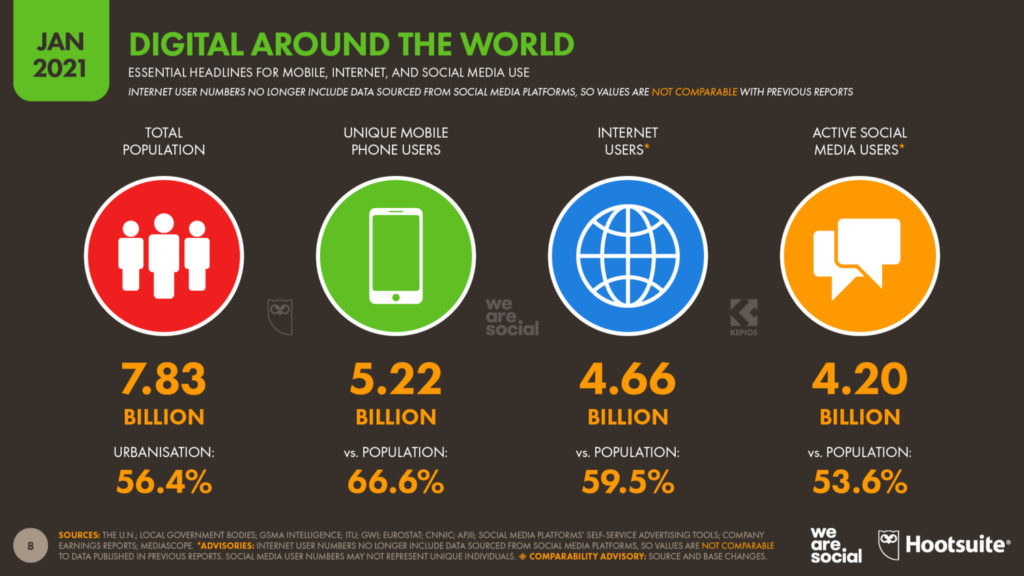
Of course, it stands to reason that, as unique mobile users and internet users both grow, as was also the case in 2020 compared to 2019, voice search would follow suit. Availability alone does not explain the phenomenon, however. There are more subtle, practical reasons as well, as Google research finds. Specifically, it outlines the following 5 key ways in which “voice assistance is shaping consumer behavior”:
- “It makes life easier”
- “It’s at the center of the home”
- “It’s part of the daily routine”
- “It offers a new, more human relationship with technology”
- “It’s a new playground for brands”
Of course, these findings offer some fascinating deeper insights, like in the case of point #4. Here, Google finds that “41% of people who own a voice-activated speaker say it feels like talking to a friend or another person”. They note that “[p]eople are engaging with their voice-activated speakers as if they were human”, which in itself is a testament to how much the technology has advanced.
In the context of this article, however, the choice of words holds interest in itself; “shaping consumer behavior”. Indeed, voice search also offers immense perceived value to users, which in turn affects their behavior.
In the aforelinked article, Invoca cites some illuminating statistics in this regard:
- “Up to 43% of voice-enabled device owners use their device to shop.”
- “51% of those who shop via voice use it to research products.”
- “11.5% of smart speaker owners make purchases by voice monthly.”
- “52% of smart speaker owners are interested in receiving info about deals, sales, and promotions from brands.”
- “93% of consumers are satisfied with their voice assistants[, and] 65% of people who own an Amazon Echo or Google Home can’t imagine going back to the days before they had a smart speaker.”
Analyzing these two in conjunction, we may pinpoint the exact reason from the consumer’s perspective; convenience. Voice search has evolved in strides over the past decade, and now offers reliable, swift, accurate results. It could only follow that users would use this technology to enhance their online shopping habits, and research affirms this.
The overlap between voice search and local search
Few points could make this relationship more abundantly clear than the overlap between voice search and local search. It is here where the impact of voice search on digital marketing and SEO truly begins to manifest.
Here, we may first cite both Google and Invoca again. In 2018, Google identified massive spikes in “near me” searches and purchase intent therein:
- “150%+ growth in mobile searches for “___ near me now””
- “900%+ growth in mobile searches for “___ near me today/tonight””
- “200%+ growth in mobile searches for “Open” + “now” + “near me””
Not only have such trends not dissipated over time, but recent research only confirms them. In fact, where one may not necessarily assume correlation, it has indeed identified that mobile search and local search both somewhat overlap with voice search. Invoca, citing BrightLocal in the above article, reports the following:
- “76% of smart speaker users perform local voice searches at least weekly.”
- “58% of consumers use voice search to find local business information.”
- “28% of consumers go on to call the business they voice searched for.”
Then, 99Firms reports on similar findings, including:
- “Approximately 46% of all searches include location.”
- “Some 76% of consumers use voice search to look for local businesses at least once weekly[, and] 28% of local searches result in a purchase.”
- “Approximately 78% of mobile local searches prompt an offline purchase.”
In tandem, these findings should consolidate all of the above into one concrete conclusion. That is, that mobile search, local search, and voice search overlap considerably. Thus, while each warrants its own attention marketing-wise, so too does their overlap.
The impact of voice search on digital marketing and SEO
With the above introduction and statistics in mind, we may now delve into our main subject. That is, the practical impact of voice search on marketers’ strategies and practices. Here, we may highlight 5 crucial elements, in no particular order.
#1 Featured snippets: the coveted “position zero”
An initial, crucial distinction that must be made lies in where virtual assistants get their answers. While Alexa’s sources remain more unclear, Google Home and Siri read featured snippets – which inadvertently informs SEO.
SEO holds that reaching the first page of Search Engine Results Pages (SERPs) holds immense value. Indeed, Forbes reports the following key findings that have fueled SEO’s pursuit of SERPs:
- The first page of SERPs gathers 71% of search clicks, with some reports finding up to 92%.
- 85% of traffic clicks on results, with only 15% trying a different search.
- On the first page, the top 5 results get 67.6% of all clicks, while the other 5 get 3.73%.
Now, featured snippets already occupied a curious place in SEO – even prior to voice search debates. Some marketers, along with copyright lawyers, suggested they steal clicks from other organic results, as SearchEngineJournal reports. While the debate lasted for long, research from Ahrefs does seem to confirm this:
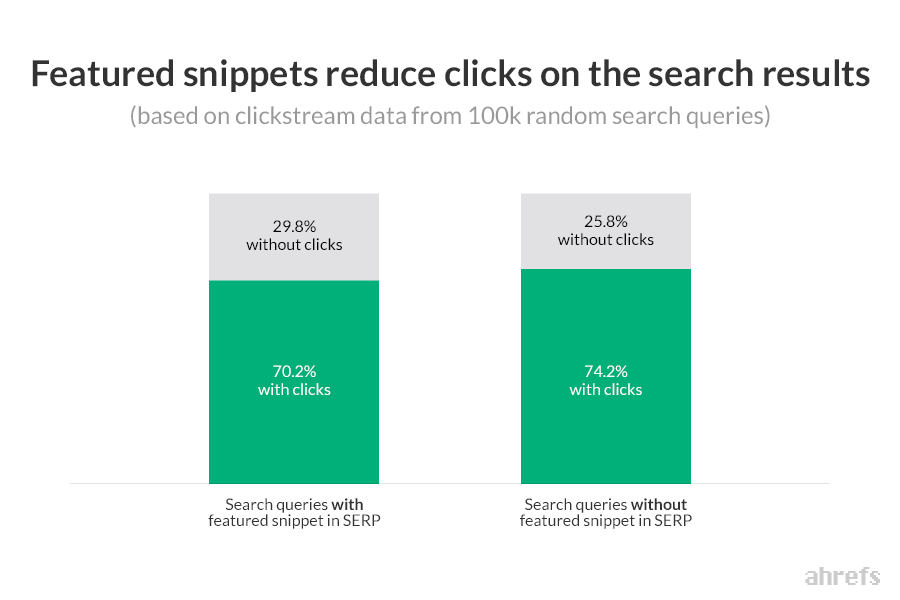
Similarly, they, and others, argued that featured snippets actually deprive the ranking websites themselves of clicks. To address this claim, many SEOs began walking a thin line; shooting for featured snippets, while also inciting clicks through them. That is, striving to both
- provide enough immediate value to satisfy search intent – a key SEO ranking factor, according to Backlinko –, and
- still encourage a click by offering additional value within the main content body.
Now, with voice search placing such a high emphasis on featured snippets, the debate is reigniting. For instance, consider the above find that organic results underneath featured snippets get more clicks than snippets do. As Google deduplicates SERP listings, snippets won’t appear in the organic results twice. In turn, some marketers perceive this as a self-inflicted sabotage, where featured snippets may increase voice search visibility but lower organic traffic clicks.
In general, however, featured snippets should maintain their appeal, on account of their sheer visibility. The impact of voice search on digital marketing and SEO does, nonetheless, extend to featured snippets. Here, marketers will need to consult their analytics, and prioritize their goals accordingly – including chasing the coveted “position zero”.
#2 Semantics of search
A similar front lies in semantics of search. As this topic too may warrant very extensive analysis, let us settle for BloomReach’s brief definition of semantic search:
“Semantic search is a data searching technique in which a search query aims to not only find keywords, but to determine the intent and contextual meaning of the words a person is using for search.”
This definition may already reveal its significance as regards SEO, but BloomReach makes it abundantly clear:
“[…] Semantic Search is related to figuring out what your user means. In fact, this type of search makes browsing more complete by understanding almost exactly what the user is trying to ask, instead of simply matching keywords to pages.”
To provide a relevant example of this concept in action, let us cite a use case by WordStream. For easier reading, let us make it into a sequential list:
- First, they conducted a voice search for the query “Zoe Saldana”. The actress is “known for her standout roles in the Avatar and Guardians of the Galaxy movies”, which will be relevant shortly.
- Then, they conducted a voice search on “What was the name of her character in Guardians of the Galaxy?”. Here, Google had not yet pinpointed the user’s interest in Zoe Saldana, so it presented various results – including her role as Gamora.
- Then, after a query on Gamora, the user inquired “How old is she?”. Here, Google assumed continued interest in Zoe Saldana, not the character of Gamora. Therefore, it offered information on the actress, which the query reflected.

In this example, Google applied semantics; it assumed who “she” referred to, based on prior queries, and adjusted results accordingly.
While this has absolutely vast implications for SEO on the whole, as we’ll explore next, it particularly highlights the principles of voice search in action. Namely, that voice search caters to the conversational tone it invites. A typical conversation would indeed have a similar flow, where follow-up questions would still reference the subject of the initial one.
In brief, it is this affinity of voice search to add semantic value that marketers must cater to. How? There are, arguably, 2 key elements; keywords, and the user intent.
#3 Keywords
Starting with keywords, the implications of search semantics should be clear. Marketers who practiced SEO already rightfully advocated for keyword versatility, including:
- Long-tail keywords. For many, due to sheer competition, single-word keywords present too much of a challenge to rank for – and understandably so. Thus, many advocate for ranking for long-tail keywords instead, which elaborate on the main subject. An example would be “long sleeveless womens’ white dress”, as opposed to “(womens’) dress”.
- Keyword synonyms. Similarly, delving into Latent Semantic Indexing (LSI) territory, keyword research dictates synonyms. For example, “footwear” may include “shoes”, “boots”, and “sandals”, or specifics, like “hiking boots” and “running shoes”.
- Local keywords. Finally, as local SEO continues to offer value in the post-COVID-19 era, so too do local keywords. Here, marketers leverage such keywords as city and location names, often with the intent of satisfying “near me” searches.
These are, largely, prudent practices, as SEO has incorporated them to address changing customer behaviors over the years. However, the impact of voice search on digital marketing and SEO arguably reveals additional elements that build on them, including:
- Natural language patterns. Voice search carries queries that follow natural language patterns, so keywords must follow suit. For example, a written recipe query may simply be “recipe for pizza”, while a spoken recipe query may be “how do I make pizza?”.
- Sentences. Similarly, written queries will typically not include full sentences – hence the apprehension for very long keywords. Spoken queries, however, do; natural language includes full questions, more so than isolated keywords. Matching the “People Also Ask” table should be a priority for voice search optimization.
- Concise answers. Finally, as with general user search intent matches, SEO rightly holds that the user intent holds immense value. Here, especially with the featured snippets’ prominence, answering questions swiftly and accurately will too.
The final point bears particular significance in our context. As the above research shows, voice search typically carries informational or transactional intent. Thus, content should seek to answer “what/when/how” informational questions, and “where/near me” transactional questions with accuracy and brevity.
#4 The user search intent
On that subject, the second element that warrants discussion is user search intent. This rightly held SEO truism asserts that results such match the user’s intent – and Google agrees.
In this regard, user search intent typically sees 3 main categories; transactional, informational, and navigational. SearchEngineJournal dubs these as “do”, “know”, and “go”, respectively:
- Transactional (do). These queries carry purchasing intent, and typically occur when customers enter their conversion phases.
- Informational (know). These queries seek information instead, and typically accompany customers’ research phases.
- Navigational (go): Finally, these queries carry specific navigational intent to known online destinations such as brand websites. Branded searches belong to this type.
Perhaps unsurprisingly, informational queries vastly outnumber all others, as CognitiveSEO finds:
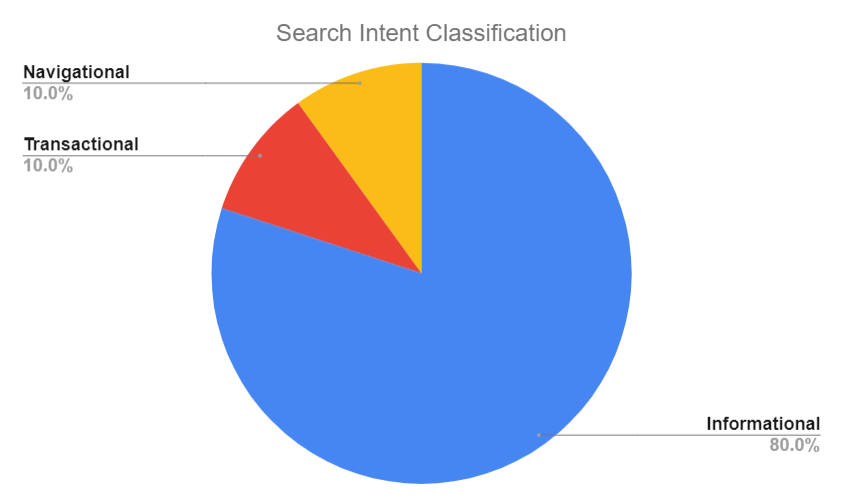
However, what presents a unique challenge in the context of voice search is perhaps semantic intent. The aforementioned Zoe Saldana example offers such a case; what does the user want to find? Here, as the user opts for natural language conventions, Google must make this deduction. Then, marketers must follow suit, and adjust their content accordingly. As above, the “People Also Ask” table offers immense assistance in this regard.
Therefore, marketers now face a unique challenge, much more so than ever before. That is, they must decipher what intent a query carries, even if it does not include explicit specifiers. For example, many understand that “running shoes” carries transactional intent, not informational. But other keywords and queries are much more subtle, and marketers need to decipher them – with voice search in mind.
#5 The emphasis on local search
Finally, having touched on local SEO manifold, let us conclude with local search. The aforecited research should offer conclusive evidence that voice search significantly overlaps with local search. In turn, they both overlap with mobile search.
This observation alone should highlight the impact of voice search on digital marketing and SEO sufficiently; local search warrants attention. In fact, it may inform practices toward future-proofing one’s website. The exact degree does depend on each business and campaign, of course, but the point stands; voice search spearheads local search, and will continue to do so in the future.
In this context, voice search carries very specific implications. In brief, the two primary ones are:
- Mobile-friendliness remains crucial. As general SEO holds, mobile friendliness remains crucial as mobile users grow exponentially. In fact, Statista finds that mobile traffic now surpasses desktop traffic. The above research also finds that mobile devices still dominate voice search, with visible effects on final conversions.
- Local SEO’s value increases. In turn, as local search carries voice search users’ transactional intent, increased emphasis on local SEO must follow suit. From optimized Google My Business profiles to local keywords, backlinks, and reviews, local traffic will be the primary benefit of voice search optimizations.
Fortunately, this final aspect of voice search doesn’t, mostly, present new challenges. Rather, it reinforces existing practices, only requiring one’s attention to the increasing prevalence of voice search.
Conclusion
To summarize, voice search has evolved in strides over the years from a novel concept it once was. Today, it has developed into a daily habit for increasingly more users, shaping their behavior in the words of Google. Thus, one can only make educated guesses on the exact impact of voice search on digital marketing and SEO. Still, research suggests that voice search will only grow over time, as it offers newfound convenience and increased result accuracy. To address this projected trend, marketers may take note of its overlap with mobile search and local search, and adjust their strategies accordingly. From featured snippets and search semantics to search intent and local SEO, voice search will require a careful approach to leverage to its fullest.
About the author

Jonah Waters is a senior copywriter and digital marketer with a keen interest in SEO, PPC marketing, and the expanding applications of CRM software. He is a frequent contributor to digitaldot.us, where he delves into the changing marketing needs across industries.


